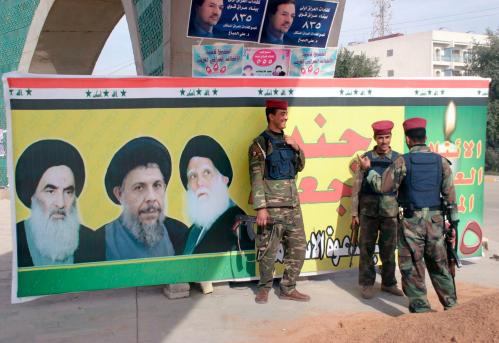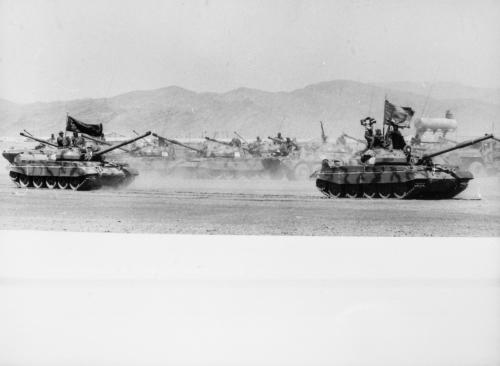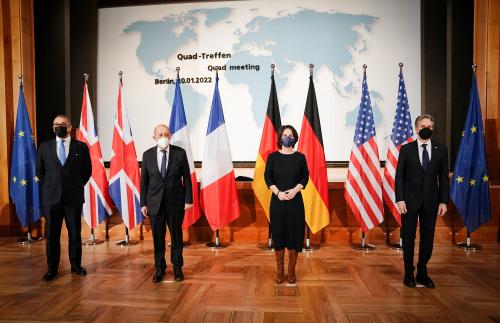On November 14, 1979—10 days after Iranian students seized the U.S. embassy in Tehran and took American diplomats as hostages—President Jimmy Carter signed Executive Order 12170, freezing Iranian government assets held in the United States. This was the first time a U.S. president used the expansive authorities offered by the 1977 International Emergency Economic Powers Act (IEEPA), but it was hardly the last example of American economic pressure applied against Iran. Today, there are eight executive orders active against Iran, each of which begins with a declaration of a “national emergency” and involves applying sanctions against the country and many of its entities and individuals. These measures, along with sanctions legislation enacted by Congress, are designed to address the full range of U.S. policy issues with Iran, from human rights to missile proliferation to terrorism.
More important, the decision to target Iranian government assets for sanctions in November 1979 has set the context for U.S.-Iran relations since. Washington has increasingly relied on economic pressure against Iran, despite persistent challenges in generating broad multilateral support.
Sanctions Options and Implementation
When the hostage crisis began, the United States had no formal sanctions in place against Iran. However, immediately following the onset of the crisis, President Carter sought options to pressure Tehran. Sanctions were selected because they were seen as severe but incremental, intended to serve both as a source of pain for the Iranians—to motivate them to release the hostages swiftly—and a warning that the United States could escalate to other options, including military force, if needed. Carter began with the prohibition of military and oil trade with Iran and quickly progressed to the more aggressive option of the asset freeze of Executive Order 12170.
 By late December 1979, the United States sought multilateral sanctions against Iran through the United Nations Security Council, but the Soviet Union vetoed the resolution. Washington continued its unilateral sanctions and requested allied and partner support.
By late December 1979, the United States sought multilateral sanctions against Iran through the United Nations Security Council, but the Soviet Union vetoed the resolution. Washington continued its unilateral sanctions and requested allied and partner support.
Several countries—including Mexico, Austria, Poland, and Sweden—joined the Soviet Union and China in countering U.S. sanctions by instead normalizing trade relations with Tehran, even expanding economic and commercial relations with Iran to offset U.S. effects in some cases. In this, they acted much as the Soviet Union did with Cuba after the U.S. embargo was imposed against the country in the early 1960s: aiding a country dependent on trade and business with the Western world to compensate from its sudden curtailment.
However, others belatedly or half-heartedly joined American efforts to pressure Tehran throughout 1980. Few governments were willing to cut off oil imports from Iran. Portugal was the first major U.S. ally to ban all trade with Iran in April 1980. Japan, the largest purchaser of Iranian crude at the time, ceased all oil imports from Iran halfway through the 15-month hostage crisis. Eventually, foreign ministers from the European community and other Western European countries agreed to reduce financial and diplomatic relations with Iran. Australia also slowly imposed a trade ban without condition on all goods except foodstuffs, their primary interest with Iran, and medicine. However, unlike the Europeans who applied sanctions only to new contracts or ones entered into force post-November 1979, Australia made it clear that their sanctions would be on every non-food contract with Iran until the hostages were released. Denmark, Britain, Norway, and Australia all recalled their ambassadors from Iran. The governments of Denmark and the U.K. passed their own economic sanctions followed shortly by West Germany, France, and Italy. And the U.S. neighbor in the north, Canada, banned all exports to Iran.
Impact on Iran
The cumulative effect of the sanctions had a substantial impact on Iran’s economy. Definitive costs are difficult to assess, in no small part because the revolution and resulting chaos had already imposed a heavy toll on the Iranian economy. For example, in 1980, U.S.-Iranian trade plummeted when U.S. exports to Iran dropped from $3.7 billion to $23 million, while imports from Iran dropped from $2.9 billion to $458 million—mostly in oil. One case study estimated that the total economic cost on Iran from 1980 to 1981 was roughly $3.3 billion.
But, while these numbers are significant, the U.S. failure to motivate its partners to respond more aggressively to the hostage crisis underscored the degree to which it was still seen as a U.S.-Iran affair. Moreover, as our Brookings colleague Suzanne Maloney points out in her book, “Iran’s Political Economy since the Revolution”: “The European reluctance to sanction Tehran over the hostage seizure preserved its traditionally preferential place in the Iranian market and trade remained steady during the early war years, nearly doubling in 1983 with more than $6 billion in European exports to Iran.”
The most effective U.S. measure was the asset freeze, which “effectively immobilized $12 billion in Iran’s assets, including most of its available foreign exchange reserves,” according to Robert Carswell and Richard J. Davis. Washington took advantage of the fact that, after the turmoil of the revolution, the Iranians were still sorting out how to manage their international financial relations and still maintained substantial reserves banked in the United States. Consequently, Washington was in a position to deliver acute, targeted, and highly disruptive pressure on a key vulnerability at the time.
The exposure to such direct pressure from the United States was a mistake that the revolutionary government sought to correct after sanctions were eventually lifted, with Tehran seeking to hold its reserves much closer to home. But, in the meantime, the cumulative impact of the specific costs imposed by the United States—coupled with the growing financial and diplomatic international pressure to release the hostages—was effective in persuading the Iranians to negotiate.
Lessons Learned
The hostages were released on January 20, 1981 via the Algiers Accords. The Accords also created an arbitration process, based in The Hague, in which the United States and Iran have negotiated solutions to various commercial disputes arising from the revolution, such as expropriations and cancelled contracts. Most recently, this process awarded a settlement for a pre-revolutionary contract for military equipment—plus interest—that resulted in a $1.7 billion transfer to Iran in January 2016.
Three broader results, though, emerged from the crisis that still affect U.S.-Iranian relations and strategy to date.
First, the United States learned that Iranian leaders—even in post-revolutionary Iran—remain guided by rational cost-benefit calculations. The revolutionary fervor that Iran’s leaders exploited to consolidate their power over internal rivals in November 1979 helped animate the decision to prolong the crisis. However, after a year that featured the shah’s death and the invasion of Iran by neighboring Iraq, Iran’s leaders understood that continuing the crisis posed far more significant risks than benefits. Iran’s leaders did not release the hostages because they changed their view of the United States or lost interest in using the crisis domestically. Rather, Iran’s leaders backed down and sought a negotiated outcome because they decided that it was in their national interest, a fact that encouraged future U.S. policymakers to seek negotiations with Tehran.
In turn, each U.S. president who has sought to use sanctions against Iran has done so with the expectation that Iran’s calculus can be shifted toward more constructive policies. For this reason, U.S. policymakers have viewed sanctions as a useful source of leverage to dissuade Iran’s support for terrorism, violations of human rights, or nuclear weapons development. Arguably, this continues to be the case under the Trump administration, which has sought to use sanctions pressure to secure a “better deal” with Iran than the Joint Comprehensive Plan of Action (JCPOA) negotiated by President Obama. Notably, this consensus is challenged by a substantial group of dissenting officials—including, prominently, National Security Advisor John Bolton—who instead see Iran as irretrievably hostile to the United States and, consequently less motivated by national interest.
Second, the experience of the hostage crisis demonstrated the advantages and limitations of applying multilateral pressure on Iran. The United States benefited from the cooperation of partners, even if that follow-on pressure was incomplete, sometimes slow, and in some cases more symbolic. Although the main economic pressure came from the United States, the broader sense of growing isolation likely incentivized Iran to cooperate. With important players like the Soviet Union and China defecting, the United States also had to find creative solutions to intensify its own sanctions—a task made harder by the fact that the countries were already less intertwined economically and politically. This creative application of U.S. sanctions pressure would find full maturity in the secondary sanctions programs of the mid-2000s, in which the United States had little to no economic contact with Iran yet still was able to exert considerable leverage by threatening access to the U.S. economy for those countries still doing business with Iran.
Third, the hostage crisis set the emotional and psychological context among Americans for nearly everything that was to come between the United States and Iran. It made restoring trade and business ties difficult, even if legal, due to the reputational risks (as Conoco discovered in 1995). It also, at times problematically, created a potential analogy for future attempts at transactional diplomacy, as President Obama experienced after the aforementioned $1.7 billion debt settlement was conflated with the release of U.S. citizens held in Iran in January 2016. This may be one of the most significant ramifications of the hostage crisis. The incoming Reagan administration criticized the Algiers Accords as an enormous concession to an act of terrorism. All future U.S. negotiations with Iran would be met with the same accusation, especially wherever sanctions relief was to be applied—this was a critical element of the JCPOA’s reception in Washington.
Such criticism did not stop U.S. administrations from both political parties from contemplating and concluding agreements with Iran involving sanctions relief and debt repayment. In this way, just as the Iran sanctions experience in 1979-81 would teach the United States much about Iranian rationality in foreign affairs, Iran too would come to recognize that it can generate leverage with the United States. Tehran has characterized its nuclear expansion from 2006-13, for example, as a means of generating leverage for negotiations as well as developing Iran’s nuclear capacity. Iran may likewise see value in regional misbehavior as a way of not only advancing its security interests, but also creating asymmetric sources of leverage against its adversaries, the United States foremost among them.
Conclusion
In the decades following the 1979 hostage crisis, the United States and Iran have sought to demonstrate a readiness to engage but, also, the limits of engagement. The use of sanctions—based on the premise that Tehran remains guided by rational cost-benefit analysis and that even tough unilateral pressure can benefit from multilateral cooperation—has been a reliable mechanism for the United States, beginning in 1979 and refined in the years that followed. The question now is whether the limits of sanctions policy have also been incorporated into U.S. strategic thought in order to ensure that they can still be used to guide negotiations.
The Brookings Institution is committed to quality, independence, and impact.
We are supported by a diverse array of funders. In line with our values and policies, each Brookings publication represents the sole views of its author(s).










Commentary
How the Iran hostage crisis shaped the US approach to sanctions
March 12, 2019